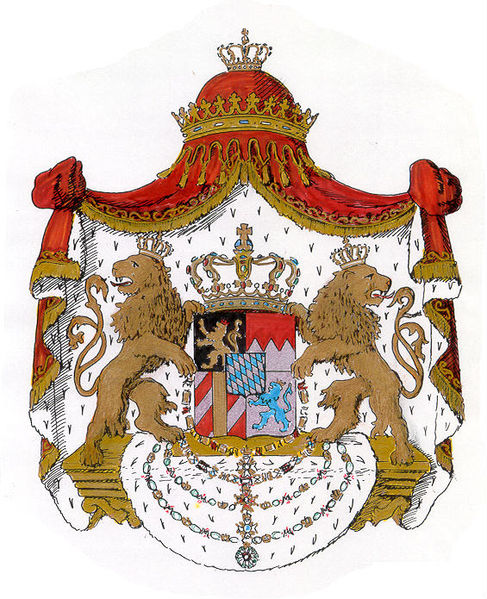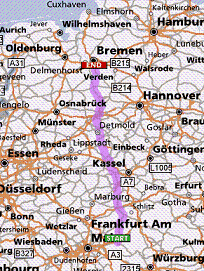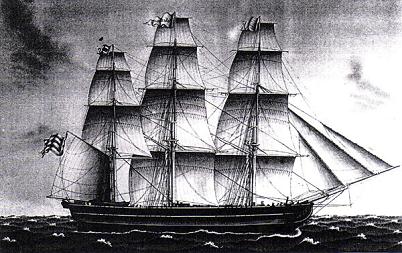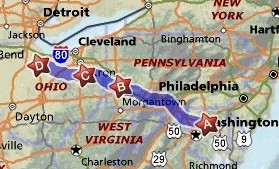|
PetersPioneers came to America from Europe on sailing ships between 1834 and 1888, a period of 54 years. This is the story of the journey of the family that we know the most about. We have their passport, a description of their journey, a picture of the ship they came on, and a copy of the passenger list. It also happens to be the first of our family to immigrate to America.
My great great great grandparents, John Adam and Maria Eva Schumm Schickell, came to America in 1834. They went by horse and wagon from their hometown in Kassel, Bavaria, to the seaport of Bremen, Prussia. They went by sailing ship from Bremen to Baltimore, Maryland. They went by horse and wagon from Baltimore to Tiffin, Ohio. Nineteen years later, in 1853, they moved from Tiffin to Grand Rapids, Michigan.

Arms of the Kingdom of Bavaria. King Ludwig I reigned from 1825 to 1847. |
|

24-star flag of the United States of America, 1822 to 1836. Ohio became a state in 1818, but Michigan would not become a state until 1837. |
|
The Schickells. There were six Schickells who came to America: John Adam, 39, a musician, and Maria Eva, 34, and their four children Veronica, 13, Mary Augusta 6, Mary Amalia, 4, and Peter, 1.

Shortest route today from Kassel (Start) to Bremen (End). Distance: 235 miles. |
Kassel. The Schickells were from the small town of Kassel, which is 32 miles east northeast of Frankfurt, Germany. At that time, Kassel was in the Main-Kreis region in the far northwest corner of the Kingdom of Bavaria. In 1866, as a result of the Treaty of Prague, Kassel became part of what is now the Kinzig-Main-Kreis region in the far south of Hesse. Kassel is now part of the town of Biebergemund.
The small town of Kassel should not be confused with the large city with the same name in Hesse, 100 miles to the north.
They obtained a passport dated August 8, 1834, that gave them permission to emigrate from Bavaria to North America. It was issued by the Police of the Kingdom at the Royal Bavarian State Court at Orb, which is five miles northeast of Kassel. The pass describes John Adam as 5 foot 7, black hair, black beard, high forehead, pointed nose, rounded chin, long face. On the back was a visa issued August 13, 1834, by the Royal Bavarian Government of the County of the Lower Main at Wurzburg, which is 55 miles southeast of Kassel.
Kassel to Bremen. To get a ship to America, the Schickells first had to travel from their hometown of Kassel to the port of Bremen, a distance of 235 miles. Assuming 20 miles per day, this would have taken 12 days. According to the notebook of John Adam Schickell, the family took their horse and wagon to Bremen.
Bremen. Bremen is on the Weser River, 37 miles from its mouth of the river on the North Sea. In Bremen, the horse was sold, and the wagon, with all their belongings, including musical instruments, was taken aboard the sailing ship Johannes.
Bremen to Baltimore. The shortest route between the ports of Bremen and Baltimore goes through the North Sea to the English Channel and across the Atlantic Ocean. According to SeaRates.com, the distance is 3800 nautical miles. A nautical mile equals about 1.15 statute miles.The voyage left Bremen on August 27, 1834, and arrived in Baltimore, Maryland, on November 29, 1834.

Passengers 46 to 50 on the list of 142 passengers that arrived in Baltimore on the ship Johannes on November 29, 1834, showing five Schickels from Cassel: Ad, musician, 39, his wife Eva, 35, Veronica, 11, Augusta, 5, and Amalia, 4. Not shown was Peter, age 1, perhaps because he was a babe in arms. Source: National Archives. The full Passenger List was obtained from the National Archives in Washington, D.C., by James Biggins. |

Ship Johannes by Jacob Boettger (German, 1781-1860), watercolor, 1835. Ship that brought the Schickell family from Bremen to Baltimore in 1834. Source: Deutsches Schiffahrtsmuseum (German Maritime Museum), Bremerhaven, Germany. |
Klaus Fuest of the German Maritime Museum has provided information about the Johannes including the picture shown here. The original picture is a water color painted by Jacob Boettger in 1835, the year after the Schickell's voyage. The ship was a fully-rigged deep water sailing ship built in the Bosse ship yard No. 41 in Burg, Germany. The ship carried 135 tons. It was 90 feet long and 28 feet wide. It drew 16 feet. It was owned by Huhlenkampff Brothers, Bremen, and launched May 29, 1828. Its captain from 1831 to 1839 was Hermann Senkstake.
A fully-rigged ship has fore, main, and mizzen masts, each with four square sails. The lowest sails are called foresail, mainsail, and crossjack (the Johannes has a spanker instead of the square crossjack on its mizzenmast). The next row are called topsails. The next are called topgallant sails. The next are called royal sails. There are three jibs: staysail, inner jib, and outer jib.
Baltimore. The ship Johannes arrived in Baltimore on November 29, 1834, with 142 passengers. The Schickells stayed with a Jewish family in Baltimore that had emigrated a year earlier from Gelnhausen, about five miles west of Kassel. The Schickells spent 80 days in Baltimore.
In 1834, the U.S. flag had 24 stars, the most recent one being for Missouri. The President was Andrew Jackson.
Batimore to Tiffin. The Schickells set off for Tiffin in Seneca County, Ohio, via Pittsburgh, Pennsylvania, and Canton, Ohio. They stayed in Pittsburgh 14 days. The total distance was 420 miles.

Shortest route today from A. Baltimore, Maryland, to B. Pittsburgh, Pennsylvania, to C. Canton, Ohio, to D. Tiffin, Ohio. Distance: 420 miles. |
Tiffin. The Schickells settled in Tiffin, where Adam worked as a musician. They had three more children born in Tiffin: Maria Appolonia in 1835, Francis Xavier in 1837, and Joseph in 1839. Francis Xavier died as a baby. In 1847, their daughter Mary Augusta, married John Schmitt, also from Kassel. John and Mary Augusta Schickell Schmitt are my great great grandparents. John was a gold miner in California from 1849 to 1851. In March 1853, their daughter Mary Amalia married Charles F. Boos, a musician. The Schickells lived in Tiffin for 19 years. In August 1853, they moved to Grand Rapids, Michigan, where the Schmitts had moved two years earlier. During the Civil War, their sons Peter and Joseph were regimental band leaders.
|
 Kassel to Tiffin, 1834
Kassel to Tiffin, 1834 Kassel to Tiffin, 1834
Kassel to Tiffin, 1834